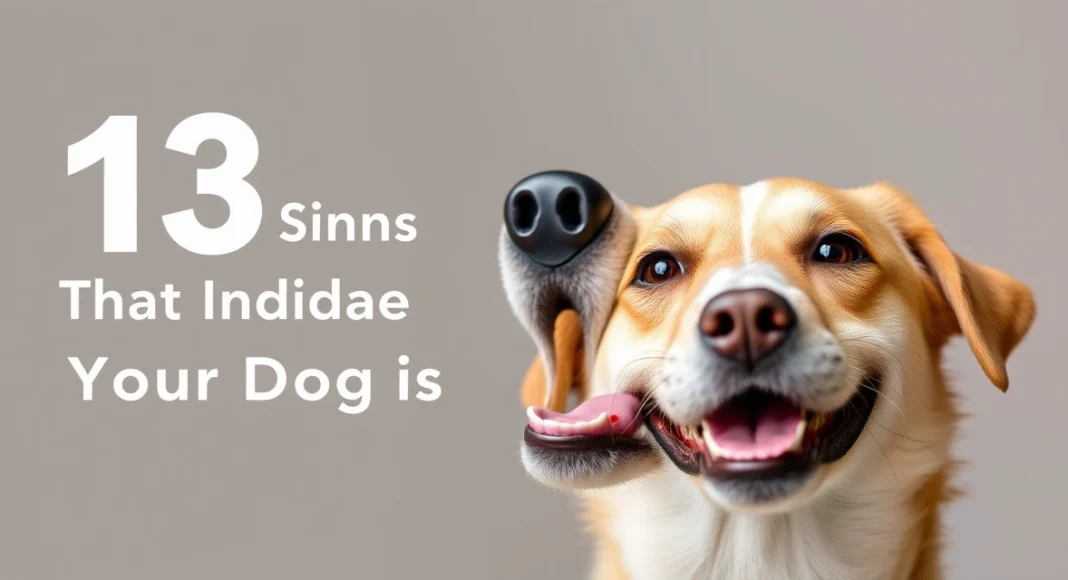13 Hidden Signs That Indicate Your Dog is Happier Than Ever
As pet owners, we all cherish the moments when our dogs display overt signs of happiness—like wagging tails, playful barks, and exuberant leaps. However, the true indicators of canine joy can often be more subtle. Understanding these nuanced signs can deepen the connection between you and your furry companion, enhancing the pet-owner bond that is so vital for both parties. In this article, we will explore 13 hidden signs that indicate your dog is happier than ever, allowing you to appreciate the quiet joy they experience in your shared life.

Recognizing these subtle signs not only enriches your understanding of your dog’s emotions but also fosters trust and companionship. By learning to read your dog’s body language and behaviors, you’ll be better equipped to support their happiness and well-being. Let’s delve into the different facets of canine happiness and discover how to interpret these often-overlooked signals.
1. Playful Behavior
While a playful demeanor is often associated with happiness, there are particular nuances in how your dog plays that can indicate their mood. If your dog initiates playtime with you or other pets, it reflects their comfort and joy. A happy dog may also exhibit a “play bow,” where they lower their front legs while keeping their rear end raised, signaling their desire to engage.
Understanding Play Styles
Different dogs have different play styles. Some may enjoy fetching, while others prefer tug-of-war or chasing games. Pay attention to what your dog enjoys most, as their eagerness to engage in these activities signifies a positive emotional state.
2. Relaxed Body Language
When a dog is happy, their body language often reflects that sentiment. Look for relaxed postures, such as a loose body, a soft gaze, and ears that are not pinned back. A happy dog is likely to exhibit a calm demeanor, lying down with their belly exposed or sprawling comfortably on the floor.
Signs of a Relaxed Dog
- Soft, relaxed eyes
- Loose, wiggly body
- Softly wagging tail (not stiff or high)
- Rolling onto their back for belly rubs
3. Increased Affection
A happy dog will often seek out affection from their owners. If your dog leans against you, nudges you with their nose, or follows you around the house, these behaviors are indications of their contentment and desire for closeness.
Affectionate Behaviors to Look For
- Seeking physical contact, such as cuddling or leaning
- Giving gentle licks or kisses
- Resting their head on your lap
4. Healthy Appetite
A significant indicator of your dog’s happiness is their eagerness to eat. A joyful dog is typically more enthusiastic about mealtime and may even exhibit excitement during feeding time. If your dog is consistently eating well and showing interest in their food, it’s a positive sign of their well-being.
Monitoring Your Dog’s Eating Habits
Keep an eye on any sudden changes in appetite, as these can indicate underlying health issues. A consistently healthy appetite is a good sign that your dog is both physically and emotionally satisfied.
5. Social Engagement
Dogs are inherently social creatures, and their happiness often manifests in their interactions with others. If your dog enjoys engaging with other dogs, people, or even children, it reflects their comfort and joy in social settings.
Indicators of Social Happiness
- Approaching new people or dogs with curiosity
- Playing well with other pets
- Exhibiting friendly behaviors, such as wagging tails or play bows
6. Vocalizations
While barking is a common way for dogs to communicate, the tone and frequency of their vocalizations can reveal their emotional state. A happy dog may bark playfully or whine with excitement, while a sad or anxious dog may bark in a more distressed manner.
Understanding Dog Vocalizations
Listen carefully to the context of your dog’s barks. Joyful barks are often higher-pitched and more frequent, indicating excitement and happiness. Pay attention to how they vocalize in different situations to understand their emotional cues better.
7. Tail Position and Movement
The position and movement of your dog’s tail can tell you a lot about their emotional state. A wagging tail is generally a sign of happiness, but the speed and direction of the wag can reveal more specific feelings. A slow wagging tail indicates a relaxed state, while a fast, enthusiastic wag often signifies excitement.
Decoding Tail Language
- High, fast wagging: Extreme happiness or excitement
- Low, slow wagging: Contentment and relaxation
- Wagging in a circular motion: Playfulness and eagerness
8. Curiosity and Exploration
A happy dog is often an inquisitive one. If your dog shows a keen interest in exploring their environment, sniffing around, and investigating new scents, it indicates they feel secure and satisfied in their surroundings.
Signs of a Curious Dog
- Sniffing objects and the ground during walks
- Exploring new areas with enthusiasm
- Investigating new toys or items in the home
9. Calmness After Exercise
After a good session of play or exercise, a happy dog will often display a sense of calm. If your dog is content to relax or nap after a vigorous play session, it suggests that they are emotionally fulfilled and happy.
Recognizing Post-Exercise Calmness
Watch for behaviors like lying down peacefully, sighing contentedly, or even rolling over for a belly rub. These signs indicate that your dog has enjoyed their activity and feels secure enough to unwind.
10. Eye Contact
Positive eye contact is a significant indicator of your dog’s feelings toward you. A dog that looks at you with soft eyes and a relaxed expression is expressing trust and affection. In contrast, averted eyes or tense expressions may indicate discomfort.
Building Trust Through Eye Contact
Encourage positive eye contact by engaging your dog during play or training sessions. This can help strengthen your bond and enhance their feelings of happiness and security around you.
11. Happy Dance or Zoomies
Many dogs exhibit a phenomenon known as “zoomies,” where they dash around the house or yard in a burst of energy. This behavior is often a sign of pure joy and excitement, reflecting their happiness in that moment.
Understanding the Happy Dance
When you see your dog performing their happy dance, it’s important to join in on the fun! This is a great opportunity to engage with your dog and share in their joy, reinforcing your bond.
12. Grooming and Self-Care
A happy dog tends to take good care of themselves, exhibiting regular grooming behaviors. If your dog is frequently grooming themselves or has a shiny coat, it’s a sign that they are content and healthy.
Signs of Healthy Grooming
- Regularly licking their paws and body
- Maintaining a well-groomed coat
- Exhibiting enthusiasm during bath time or grooming sessions
13. Sleeping Soundly
A happy dog will often sleep soundly and peacefully. If your dog is curling up in a comfortable spot and snoozing without any signs of anxiety or restlessness, it indicates they feel safe and happy in their environment.
Indicators of a Contented Sleeping Dog
- Relaxed body posture while sleeping
- Occasional playful dreaming (like twitching or light barking)
- Seeking cozy, safe spaces to rest
Frequently Asked Questions (FAQ)
1. How can I tell if my dog is happy?
Look for signs such as playful behavior, relaxed body language, social engagement, and a healthy appetite. Happy dogs often seek affection and exhibit a calm demeanor.
2. What should I do if my dog shows signs of stress instead of happiness?
If your dog displays signs of stress, such as excessive barking, hiding, or a tense body posture, it’s crucial to assess their environment and seek solutions, which may include reducing stressors or consulting a veterinarian.
3. Can a dog’s happiness change over time?
Yes, a dog’s happiness can change due to various factors, including changes in their environment, health issues, or changes in routine. Regularly monitoring their behavior can help you identify any shifts in their emotional state.
4. How can I improve my dog’s happiness?
To improve your dog’s happiness, provide regular exercise, engage in interactive play, maintain a healthy diet, and foster a secure and loving environment. Regular vet check-ups are also essential for their overall well-being.
5. Is it normal for dogs to have mood swings?
Yes, dogs can experience mood swings influenced by various factors like changes in their routine, environmental stressors, or health issues. Understanding your dog’s typical behavior can help you identify any concerning changes.
Conclusion
Understanding the hidden signs of your dog’s happiness can significantly enhance your relationship with them. By recognizing these subtle cues and behaviors, you can create a more supportive and joyful environment for your canine companion. Remember to cherish those moments of connection, whether it’s through play, affection, or simply enjoying each other’s company. A happy dog is a testament to the love and care they receive, making it essential for every pet owner to recognize and nurture their furry friend’s emotional well-being.
📰 Original Source
Este artigo foi baseado em informações de: https://iheartdogs.com/subtle-signs-your-dogs-in-a-great-mood/?utm_source=rss&utm_medium=rss&utm_campaign=subtle-signs-your-dogs-in-a-great-mood




